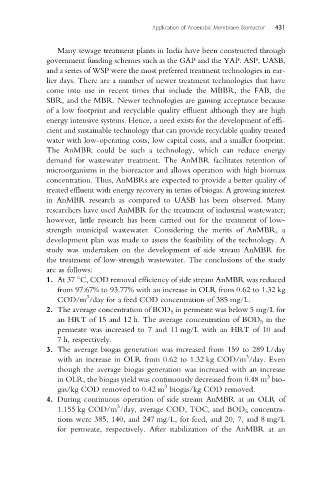Page 461 - Industrial Wastewater Treatment, Recycling and Reuse
P. 461
Application of Anaerobic Membrane Bioreactor 431
Many sewage treatment plants in India have been constructed through
government funding schemes such as the GAP and the YAP. ASP, UASB,
and a series of WSP were the most preferred treatment technologies in ear-
lier days. There are a number of newer treatment technologies that have
come into use in recent times that include the MBBR, the FAB, the
SBR, and the MBR. Newer technologies are gaining acceptance because
of a low footprint and recyclable quality effluent although they are high
energy intensive systems. Hence, a need exists for the development of effi-
cient and sustainable technology that can provide recyclable quality treated
water with low-operating costs, low capital costs, and a smaller footprint.
The AnMBR could be such a technology, which can reduce energy
demand for wastewater treatment. The AnMBR facilitates retention of
microorganisms in the bioreactor and allows operation with high biomass
concentration. Thus, AnMBRs are expected to provide a better quality of
treated effluent with energy recovery in terms of biogas. A growing interest
in AnMBR research as compared to UASB has been observed. Many
researchers have used AnMBR for the treatment of industrial wastewater;
however, little research has been carried out for the treatment of low-
strength municipal wastewater. Considering the merits of AnMBR, a
development plan was made to assess the feasibility of the technology. A
study was undertaken on the development of side stream AnMBR for
the treatment of low-strength wastewater. The conclusions of the study
are as follows:
1. At 37 C, COD removal efficiency of side stream AnMBR was reduced
from 97.67% to 93.77% with an increase in OLR from 0.62 to 1.32 kg
3
COD/m /day for a feed COD concentration of 385 mg/L.
2. The average concentration of BOD 5 in permeate was below 5 mg/L for
an HRT of 15 and 12 h. The average concentration of BOD 5 in the
permeate was increased to 7 and 11 mg/L with an HRT of 10 and
7 h, respectively.
3. The average biogas generation was increased from 159 to 289 L/day
3
with an increase in OLR from 0.62 to 1.32 kg COD/m /day. Even
though the average biogas generation was increased with an increase
3
in OLR, the biogas yield was continuously decreased from 0.48 m bio-
3
gas/kg COD removed to 0.42 m biogas/kg COD removed.
4. During continuous operation of side stream AnMBR at an OLR of
3
1.155 kg COD/m /day, average COD, TOC, and BOD 5 concentra-
tions were 385, 140, and 247 mg/L, for feed, and 20, 7, and 8 mg/L
for permeate, respectively. After stabilization of the AnMBR at an

